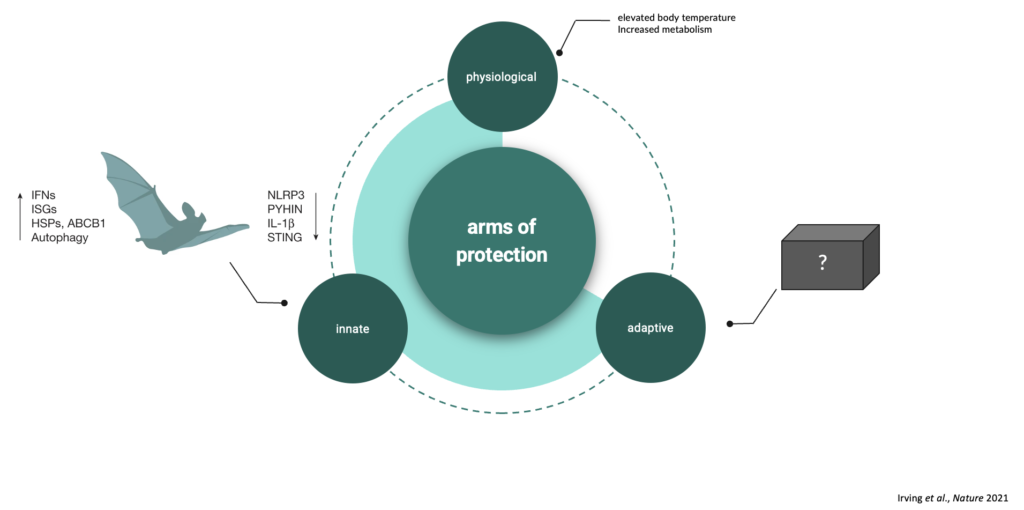Bats can be terrifying — from their fantastical association with vampires to their less fantastical, very real propensity for spreading rabies. These winged mammals have provoked fear in many people no matter how cute they are (to some!). But they might also be the key to solving some of the biggest mysteries in virology and immunology.
Last fall, we shared Part 1 of this two-part series detailing the Schmidt Lab’s experience with fieldwork in Kenya, capturing, tagging, and collecting samples from bats in the Taita Hills . If you missed it, check out that article here.
But what happens after the samples are collected? Bats can carry some of the most dangerous viruses known to humans without appearing to succumb to them. From SARS-like coronaviruses to Ebola viruses, bats can carry them while suffering no ill effects themselves, but have extremely high morbidity and mortality in the human population.
How they do so remains an open question that the Schmidt Lab, along with their collaborators, hope to address with their research.
An Open Question
“We’re very interested in trying to understand what role the bat adaptive immune system plays in controlling these viruses and helping to harbor them,” Ragon faculty member and associate professor of Microbiology at Harvard Medical School, Aaron Schmidt, PhD, said.
“These viruses often have little to no symptomatic effects in bats,” noted Daniel Maurer, a graduate student in the Harvard Program in Virology and member of the Schmidt Lab. “There are over 1,000 species of bats. So within each of these species, how do their antibody responses differ?”
Schmidt explained there are competing thoughts about how bats can appear to harbor so many viruses.
“The major one supported by increasing evidence is the role of the innate immune response and subsequent control. This innate immune control is comparable to one present in humans that bats use to coexist with these viruses,” Schmidt explained. “A more controversial suggestion is that they maintain elevated temperatures so that they are almost always in a “fever-like” state, which helps control the virus, comparable again to how humans respond to viruses.”

The Schmidt Lab, however, is focusing instead on the role of adaptive immunity in bats — the production of antibodies that are specific to an antigen and analogous to the response of humans.
“Bats are mammals like us with an adaptive immune system that is quite similar to ours,” Schmidt said. “It’s arguably a black box right now as to what exactly these antibody responses are, and if they’re doing anything to contribute to controlling viruses the same way that our own adaptive immune system does.”
However, studying the bat samples retrieved is a complicated process involving the logistical challenges of transporting samples internationally as well as storing them — something that necessitates a high degree of precautionary measures.
“It is difficult to get bat samples into the United States and rightfully so,” Schmidt said. “There are, for good reason, a lot of strict import and export permits.”
Global Collaboration
The Schmidt lab was fortunate to collaborate with researchers from the University of Arkansas as well as the University of Helsinki on the sample-collecting trip to Kenya. This collaboration allowed for the team to overcome these challenges by each handling a different part of the research.
University of Helsinki researcher Tarja Sironen, PhD, played an important role. Sironen’s lab, One Health, has the capacity to transport and store samples collected from the bats in Finland. They can, under appropriate safety precautions, extract bat genomic RNA from their spleens and then send this RNA (without any viral material) to the Ragon for further study.
“We have an amazing collaboration between the three groups with complementary expertise.” Schmidt noted, “Kris Forbes [from the University of Arkansas] and his team leads the capturing of the bats and the subsequent sampling; the Helsinki team does the bat RNA extractions along with testing for viruses from the samples; they then send us the bat RNA in a biosafe container to conduct research with.”
Unlike the raw organic samples collected from the bats, the extracted bat RNA itself does not contain any foreign viruses and can be stored and transported safely. The Ragon’s research involves using that extracted bat RNA for antibody discovery — ultimately creating a bank of different bat antibodies to see how they recognize various viruses.
“What we’re hoping to do is to screen bat antibodies against different viral glycoproteins to see what types of responses these bats have against different viruses,” said Anne Roffler, a graduate student in the Harvard Biological and Biomedical Sciences PhD Program doing their thesis in the Schmidt Lab.
Through this research, they hope to come closer to understanding adaptive immunity in bats and their ability to coexist with often-lethal viruses.
There are tentative plans for Schmidt Lab members to spend time in Helsinki conducting research with Sironen and her group. It’s an exciting opportunity that presents the chance to study additional bat samples that are difficult to transport to the US, such as B cells which can’t readily be separated from foreign viral material.
“With the proper biosafety level,” Roffler said, “we will be able to work with actual bat samples, not just the extracted bat RNA, to directly look at their B cell reservoirs.”
Eventually Schmidt’s team hopes to have the capacity to conduct this research right here at the Ragon. But for now, their RNA work is an important step forward in bat research that brings us closer to understanding their incredible immune systems.


 Ragon Institute
Ragon Institute 